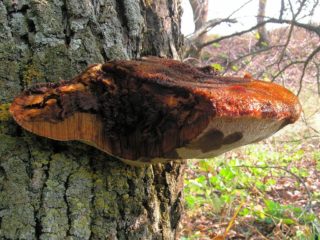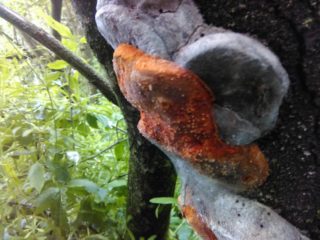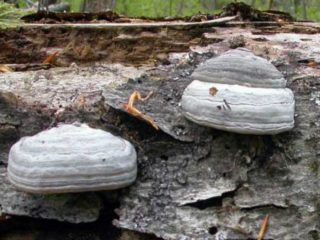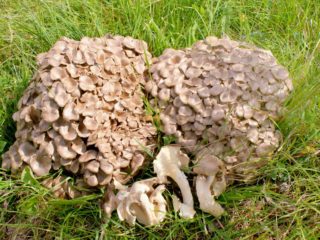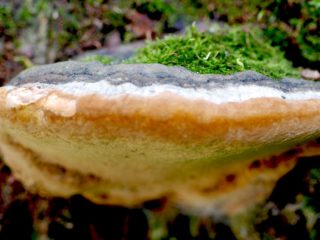Content
The false aspen tinder fungus (Phellinus tremulae) is a perennial organism that has been parasitizing trees for several decades. Belongs to the Gimenochaetaceae family, genus Fellinus. Its other names:
- Fomes igniarius, 1935;
- Fomes tremulae, 1940;
- Ochroporus tremulae, 1984
Important! Aspen tinder fungus causes yellow heart rot with a characteristic odor, gradually killing the host trees and causing the formation of windbreaks.
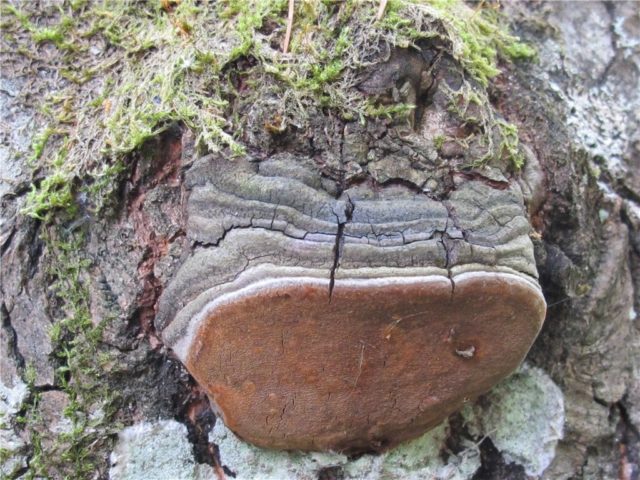
Aspen tinder fungus - a dangerous biotrophic fungus
What does an aspen tinder fungus look like?
First, at the sites of damage to the bark or fractures, rounded reddish-brown, orange or gray-gray spots of irregular shape appear, rather small, with a diameter of 0.5 to 15 cm. They are tightly pressed to the bark, have a glossy bubble surface.
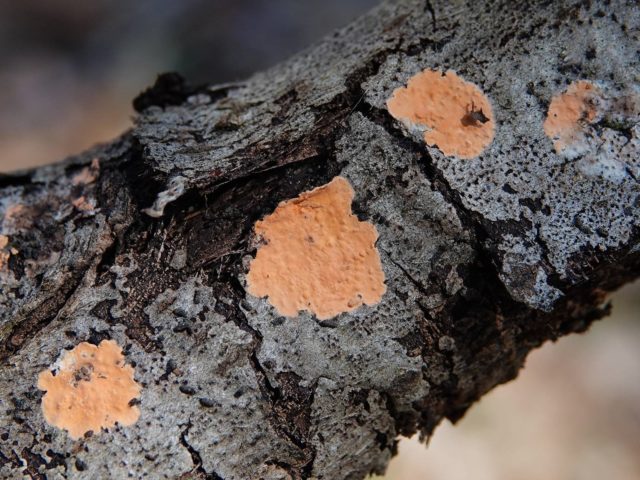
Aspen tinder fungus in the early stages of development
Then the fruiting body acquires a hoof-like, thickened-disc-shaped or tortoiseshell shape. The leg is absent, the mushroom grows sideways to the surface of the tree, very tightly. It takes a lot of effort to pull it off. The width of the cap varies from 5 to 20 cm, the thickness at the base is up to 12 cm, and the length can be up to 26 cm. The upper part is flat or sloping, with distinct concentric relief stripes of various widths. The crust is glossy, dry, smooth; with age, it becomes covered with a network of rather deep cracks. The color is gray-greenish, black, ashy, dirty beige.
The edge can be sharp, rounded or ridged. Has a lighter color - whitish-gray, yellowish, red. The geminophore is tubular, finely porous. The surface is silky, glossy, bumpy or evenly rounded. The color changes with maturity from ocher-red and brownish-red to light gray with brown spots in old age. Spores are whitish or yellowish.
The pulp is woody, brownish-brown or reddish-dark. The lower spongy layer can be relatively thin or have a pillow-like shape that extends along the substrate.
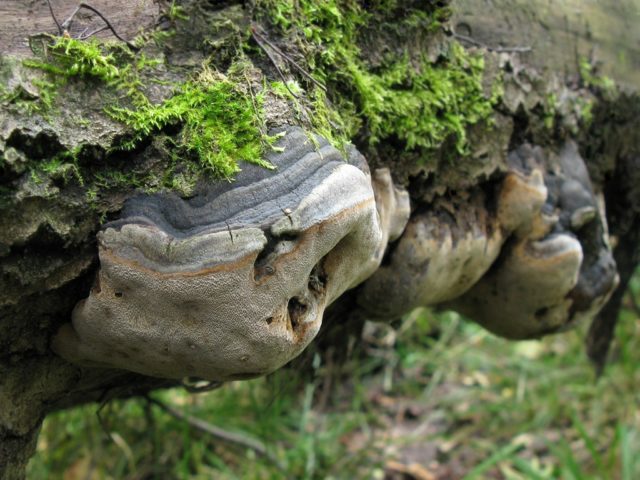
Aspen tinder fungus sometimes looks like a sloppy, flattened-broken growth on a tree trunk
Where does the aspen tinder fungus grow
Aspen tinder fungus is a pathogenic fungus that mainly specializes in aspen trees. It affects trees over 25 years old; in old aspen forests it can spread at high speed, infecting up to 85% of the forest. The mycelium grows inside the tree, occupying the entire central part and forming growths on broken branches and along the entire length of the trunk.
Fruit bodies are found in aspen forests, old plantings and parks in Russia and Europe, in Asia and America. They grow on live, weakened or damaged trees, old stumps, fallen trunks, dead wood. You can see this perennial throughout the year. The active development of mycelium begins in May and continues until autumn frosts in October-November.
In unfavorable years, the development of the mycelium stops, and the few fruiting bodies grow deformed.
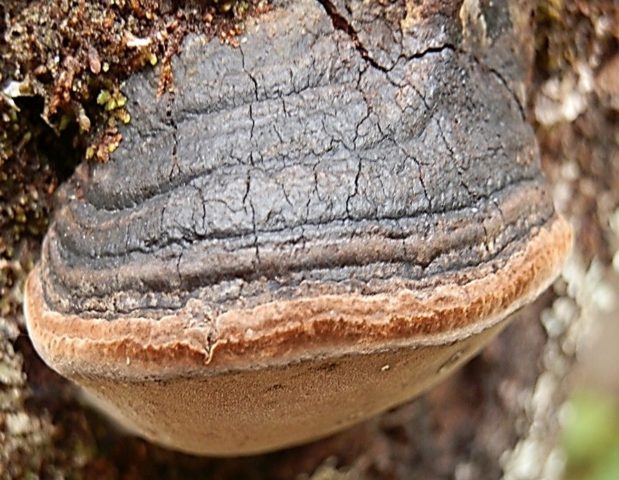
In rare cases, aspen tinder fungus grows on poplars
Is it possible to eat aspen tinder fungus
The aspen tinder fungus is classified as an inedible species. Its pulp is bitter, corky, tough, and has no culinary value. The biologically active substances contained in the composition of the fruit body allow it to be used for medicinal purposes.
Medicinal properties and use of aspen tinder fungus
Aspen tinder fungus is used in folk medicine as a remedy for diseases of the genitourinary system. It helps with the following problems:
- inflammation of the prostate gland;
- urinary incontinence, cirrhosis and hepatitis of the liver;
- to remove toxins and toxins from the body, normalize metabolism;
- with inflammatory processes and diabetes mellitus.
To prepare a healing infusion, you need to grind a fresh mushroom.
- For 40 g of raw materials, take 0.6 liters of water, bring to a boil over low heat and cook for 20-25 minutes.
- Close tightly and leave for at least 4 hours.
Take 1 tbsp. l. 40-50 minutes before each meal. With enuresis - 40 ml of decoction before bedtime. The course of treatment is 2 weeks, then you need to take a break for at least 7 days. The treatment can be continued until 900 g of the mushroom has been used.
The broth can be used for external compresses. They perfectly relieve pain and inflammation in the joints and with gout. Promote the healing of trophic ulcers, boils and wounds. Gargling of the throat and mouth is also indicated for stomatitis, ulcers, inflammation and tonsillitis.
https://www.youtube.com/watch?v=1nfa8XjTmTQ
Contraindications to the use of aspen tinder fungus
In addition to its medicinal properties, aspen tinder fungus also has contraindications. With great caution, medicines based on it should be used for people prone to allergic reactions: rashes, itching, urticaria are possible. It is also prohibited to use tinder fungus in the following cases:
- pregnant and lactating women;
- children under 12 years old;
- persons suffering from urolithiasis;
- with diarrhea, bowel disorders.
Improper treatment and excess dosage can cause dizziness, nausea, and vomiting.

Original growth similar to elephant legs
Conclusion
The aspen tinder fungus is a parasitic arboreal fungus and lives exclusively on adult aspen trees. It is widespread throughout the Northern Hemisphere, including the territory of the Russian Federation. The fruit body is inedible due to the tough woody pulp and bitter taste. Does not contain toxic substances. Aspen tinder fungus is used in folk medicine and has a number of contraindications. Before using decoctions and infusions with it, you should consult a specialist.
